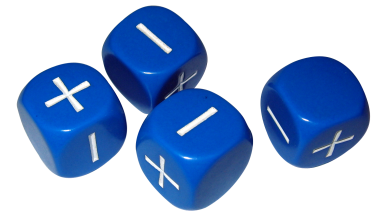
In the tabletop roleplaying game system Fate Core, actions are resolved by rolling four “Fate dice” (also known as Fudge dice), adding a relevant skill modifier, and comparing the result to a static number (or the results of an opposing dice roll). The dice have possible results of +, -, and [blank], each with equal probability. Fate interprets these results as +1, -1, and 0. A nice thing about Fate dice is that no matter how many you roll together, their sum will average around zero, so it’s easy to change the variability or “swinginess” of your results without changing their expected (average) value.
That said, the main Fate Core book (and every Fate game book I’ve read) seems to stick with four Fate dice for every roll, always, without any mention of exceptions. This is generally due to the fact that Fate is primarily a narrative-focused game, and simplicity is valued above all else when it comes to resolution mechanics. The way a player modifies the success rate of his character’s actions is by roleplaying; aspects and Fate points are a brilliant bit of game design that share the storytelling responsibility with the players, which often encourages awesome heroic moments (learn more about it here).
But who’s to say that introducing some occasional complexity to the core mechanic couldn’t add some narrative interest to a scene? Of course, we don’t want to go overboard; the mechanics should largely be invisible in a narrative-focused game, only serving their purpose of adjudicating uncertainty and not taking up too much of the players’ brainspace (nor encouraging the players to “metagame”; the mechanics should be flexible, simple, and trustworthy enough that players will have little incentive to look for loopholes to exploit). But I think something can be said for changing the number of Fate dice for effect once in a while.
For example: Let’s say a character wants to lift a heavy portcullis to let his friends pass through a gate. He must roll four Fate dice and add their result to his Strength score, along with any situational bonuses, and exceed a target value of 5 to successfully lift it. Depending on his Strength score + bonuses, his probability to succeed looks like this:

The above curve is the same spread of probabilities for literally every other action in the game. Shooting a target, evading detection, persuading a traveling minstrel to sell his adorable pet ferret, all of these actions have the same uncertainty built in, only shifting the curve left or right using the static bonuses and difficulties. But generally, there’s not a lot of uncertainty in someone’s ability to lift a heavy thing. Sure, there’s a little; your 1-rep max bench press weight might slightly fluctuate due to adrenaline and other factors, but perhaps not enough uncertainty for it to be a primary source of tension in the scene (as determined by the players at the table, of course). So how do we model a narrower range of probabilities? Simple: remove Fate dice.

If the game master decides that the outcome of a given action, such as lifting the portcullis, should only lightly depend on randomness, he could ask the player roll only one or two Fate dice rather than four, to narrow the range of likely outcomes and give more narrative power to the character’s skill and the situational bonuses he and his team accumulate. If you prefer numbers, consider this: 4dF’s expected value is zero, like all Fate dice rolls, and its uncertainty is 1.633 (the standard deviation of all 81 possible dice outcomes). Said another way, about 70% of the time, the results of a 4dF roll will be 0, plus or minus 1.633. For 3dF, the uncertainty is 1.414. For 2dF: 1.155. For 1dF: 0.816. So as we decrease the size of the Fate dice pool, we reduce the uncertainty and narrow the spread of possible results.
Here’s another example: the player characters are engaged in a gunfight in a dark warehouse. Since everyone is having a hard time seeing each other, we might want to increase the randomness and the feeling of chaos of the scene by manipulating the roll uncertainty. Instead of rolling 4dF for an attack or defense action, roll 2dF and double the result. A -1 becomes a -2, a +2 becomes a +4, etc. In this way we can increase the uncertainty of the dice roll from 1.633 to 2.309.
If you play Fate, consider this an optional rule: If you would like to reduce the uncertainty of a dice roll by about half a point, use 2dF rather than 4dF. If you would like to increase the uncertainty by about half a point, use 2x 2dF rather than 4dF. This tool should only be used sparingly for effect, but I think it opens up some interesting possibilities.
